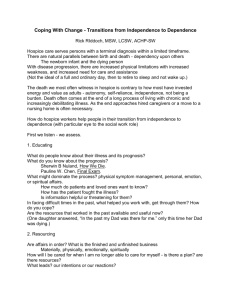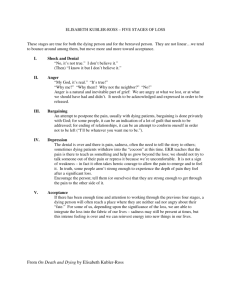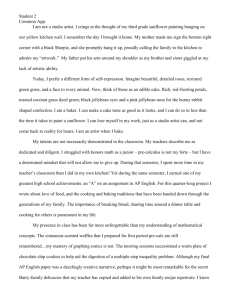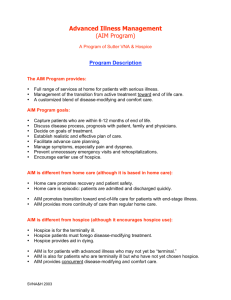Understanding Death and Dying
advertisement
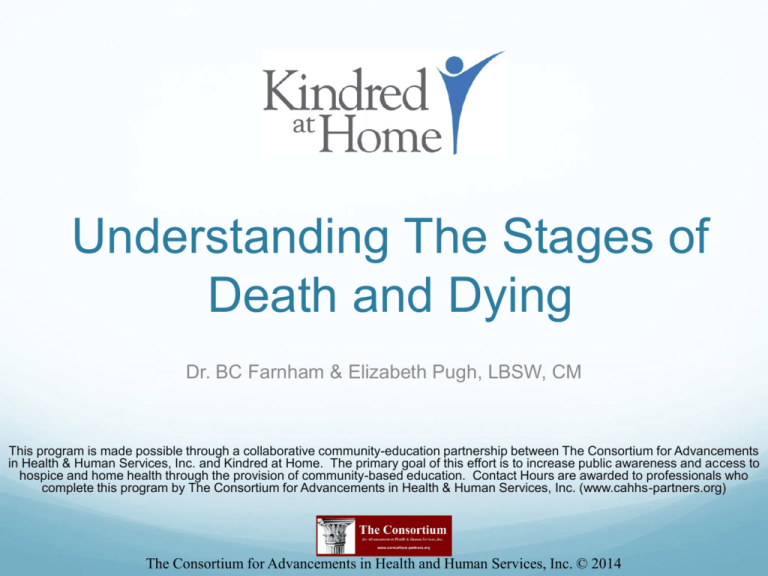
Understanding The Stages of Death and Dying Dr. BC Farnham & Elizabeth Pugh, LBSW, CM This program is made possible through a collaborative community-education partnership between The Consortium for Advancements in Health & Human Services, Inc. and Kindred at Home. The primary goal of this effort is to increase public awareness and access to hospice and home health through the provision of community-based education. Contact Hours are awarded to professionals who complete this program by The Consortium for Advancements in Health & Human Services, Inc. (www.cahhs-partners.org) The Consortium for Advancements in Health and Human Services, Inc. © 2014 Important Information This education program for healthcare professionals was developed by The Consortium for Advancements in Health and Human Services, Inc. (CAHHS) and is facilitated by Kindred Hospice via a community education partnership agreement. CAHHS is a private corporation and is solely responsible for the development, implementation and evaluation of its educational programs. There is no fee associated with receiving contact hours for participating in this program titled, Understanding the Stages of Death and Dying. However, participants wishing to receive contact hours must offer a signature on the sign-in sheet, attend the entire program and complete a program evaluation form. The Consortium for Advancements in Health and Human Services, Inc. is an approved provider of continuing nursing education by the Alabama State Nurses Association, an accredited approver by the American Nurses Credentialing Center's Commission on Accreditation. The Consortium for Advancements in Health & Human Services, Inc., is approved as a provider of c ontinuing education in Social Work by the Alabama Board of Social Work Examiners, #0356, Expiration Date: 10/31/2016. This program is Approved by the National Association of Social Workers (Approval #886684291-5176) for 1Pain/Symptom Management continuing education contact hour. In most states, boards providing oversight for nursing and social work recognize contact hours awarded by organizations who are approved by another state's board as a provider of continuing education. If you have questions about acceptance of contact hours awarded by our organization, please contact your specific state board to determine its requirements. Provider status will be listed on your certificate. CAHHS does not offer free replacement certificates to participants. In the event that CAHHS elects to provide a replacement certificate, there will be a $20.00 administrative fee charged to the individual who requests it. Learning Objectives Discuss the various psychosocial tasks associated with the final days of life. Identify the five stages of dying as outlined by Kubler-Ross. Discuss patient behaviors associated with each of the five stages of dying as outlined by Kubler-Ross. Discuss how healthcare professionals and family members can help patients experiencing the five stages of dying as outlined by Kubler-Ross. Identify benefits of hospice care that support patients facing a terminal illness. The Final Days of Life Significant for many patients, because they use this time to say goodbye, resolve unfinished business and to complete the various developmental tasks associated with the end-oflife. The Final Days of Life In order for patients to realize the power of the hospice benefit, professionals must be comfortable with talking about death and dying with patients and their loved ones. Professionals must offer empathy, education, and compassion, while demonstrating unconditional positive regard and sincerity. The Final Days of Life During the final moments of life, a hospice professional must be comfortable with the idea of “being there” for patients and their family members. There is tremendous power in presence. The entire interdisciplinary team is involved in caring for the dying patient and their family. All team members work closely with one another to provide individualized care to the patient and their family members, as the needs of each patient and family are different. Five Stages of Dying: Kubbler-Ross 1. Denial 2. Anger 3. Bargaining 4. Depression 5. Acceptance Denial “This can’t be happening to me…” The patient denies the realities and terminality of an illness. Patients may appear “emotionally shocked.” Denial is a natural defense mechanism that enables a person to monetarily escape the anxiety or emotional reactivity associated with a life circumstance. Denial enables one to gain the time needed to frame or compartmentalize the initial reactions to “bad news.” Denial continued Patient Behavior Questions the validity of lab tests, changes doctors, attributes symptoms to less threatening conditions or diseases. Patients may accept a diagnosis, but believe he/she is going to beat the odds through aggressive treatment. Denial continued How to help: Respect the patient’s natural defense mechanism. Be aware of your own behavior affecting the patient’s openness. After a patient has employed denial for a reasonable amount of time, it is appropriate to start reframing dialogue in a manner that gentle explores “What if…” or “I would feel…” statements. Anger “Why is this happening to me?” This is a reflex-based and self-protective response to fear and pain. A patient is angry because of a perceived unfairness that God and/or fate has singled him/her out for illness, while others are able to remain healthy, functional and free from the terminality of an illness. Anger continued Patient behavior: May be impatient, restless, rude, hypersensitive, unappreciative, combative or overly demanding. The patient may demonstrate a cycle of behaviors that center on isolation-attack behaviors. Patients may be combative or attacking of God, clergy and/or religion. Anger continued How to help: Embrace the patient’s anger and recognize it is a natural process. Be supportive and understanding of the patient’s need to act out and to be vocal about feelings. Attempt to communicate about the patient’s feelings of anger and hostility, as the emotions are likely rooted in fear. Avoid dialogue that dismisses the patients feelings, as being “Pollyanna” will not make things better. Feelings must be felt and explored. Bargaining “This is happening to me, but…” Patients will often attempt to delay death by bargaining with God or with healthcare professionals, which may involve making promises in exchange for more time. “If you do this… I will do that.” Bargaining continued Patient Behaviors: Engages in dialogue that is attempting to negotiate prognosis of the illness. Bargaining Statements will be something like this, “If I can make it to her wedding date” or “I will be ready to go once I have seen him graduate from college.” Bargaining continued How to help: Recognize and respect the persons need to bargain, as it is a key aspect of preparing for the end of life. Help the person focus on attainable goals that are immediate, as time is never guaranteed to any of us. Avoid talking in terms of time and help the person focus on outcomes or achievements that can be realized. Depression “Oh no… it is me” The patient experiences full realization that he/she is going to reach the end of life and die. Depression is a symptom and a defense mechanism that prepares the patient for the magnitude of the impending loss of life. Depression continued Patient Behavior: May be tearful, self isolate, withdraw from family and friends, dwell on past failures or future losses. May be restless and have a loss of appetite. Patient my have radical changes in sleep patterns. Depression continued How to help: Let the patient know its okay to cry and to experience the loss. Provide presence and increase social/emotional support. Help patient find spiritual peace if appropriate and consistent with patient’s belief system. Support patient as he/she works through various tasks associated with finding closure and saying goodbye to significant others. Acceptance “I am ready.” Acceptance is not marked by bitter resignation or tremendous joy, as it is a peaceful acceptance of one’s fate. Often patients will express a desire to reach an end of their suffering or the suffering of others. Acceptance continued Patient Behaviors: Sense of peace and “letting go” or “giving it all up to God.” Peaceful balance with regard to emotional status. Focus shifts to the immediate, and sometimes patients narrow the social support systems to only include immediate family and very close friends. Patients may elect to disengage with family members. Acceptance continued How to help: Take time to foster meaningful communication and socialization, if the patient is able and desires to speak or socialize. Shift social supports to the family and close friends, as they will need to support and to address anticipatory grief and their impending loss. Be present, responsive and available. Dying is an Individualized Experience • There is no such thing as a---typical death. • Each person dies in their own way, own time, and with their own culture, belief system, values and unique relationships with others. • When patients are aware of their approaching death, they often know where they want to die and with whom they want to die. • Healthcare professionals need to advocate for patient/family choices related to death and dying--specifically to where they wish to die, who they wish to be present and accessing effective pain and symptom management through hospice. The Benefits of Hospice Care Patients and their family members can benefit from the expertise of an interdisciplinary team, which address the physical, emotional and spiritual aspects of the end of life. Patients and families are offered effective pain and symptom management, which improves the quality of life. Patients and their family members are afforded educational supports that decrease the anxiety associated with a terminal illness. Patients and their family members are afforded choice about where they die, and “home” becomes a viable option. The Benefits of Hospice Care continued • Access to healthcare specialist 24/7. • Ongoing emotional support and counseling services are available. • Bereavement services are provided to the entire family throughout the course of the illness and for 13 months following the death of a patient. • Patients and family members are not alone in their journey, as they are supported by nurses, social workers, chaplains, bereavement counselors, hospice aides and volunteers. How Can You Help? Offer hospice services to your patients and their family members. Encourage people you know personally who are facing a terminal illness to explore hospice and to learn more about the services provided. Talk about death and dying to determine what services and supports are needed. Volunteer with a hospice program. Remember, hospice care is about improving quality of life and most hospice patients state they wish they had received services sooner. Recognize and respect the various natural stages associated with the end of life. Never underestimate the power of presence or a compassionate shoulder… be there for people during the end of life. References The stages of grief. (n.d.). Retrieved July 16, 2010 from Memorial Hospital website: http://www.memorialhospital.org/library/general/stress-the3.html What are the stages of grief. (n.d.). Retrieved July 16, 2010 from Cancer Survivors.orgwebsite: http://www.cancersurvivors.org/Coping/end%20term/sta ges.htm Wang_Cheng, B. (2002). Fast fact and concept: Dealing with anger. Retrieved July 16, 2010 from End of Life/Palliative Education Resource Center website: http:// www.mywhatever.com/cifwriter/library/eperc/fastfact/ ff59.html Questions & Answers: Complete Program Evaluations & Award Certificates
